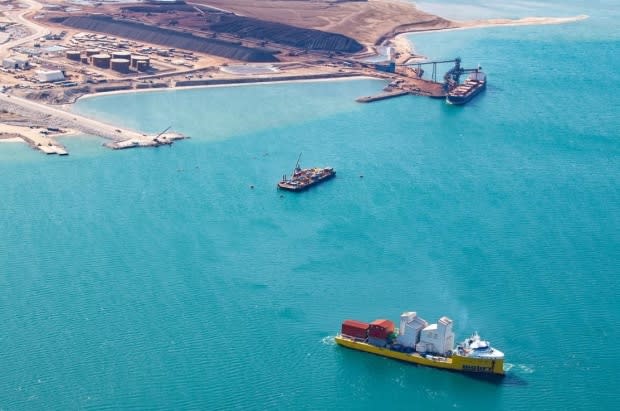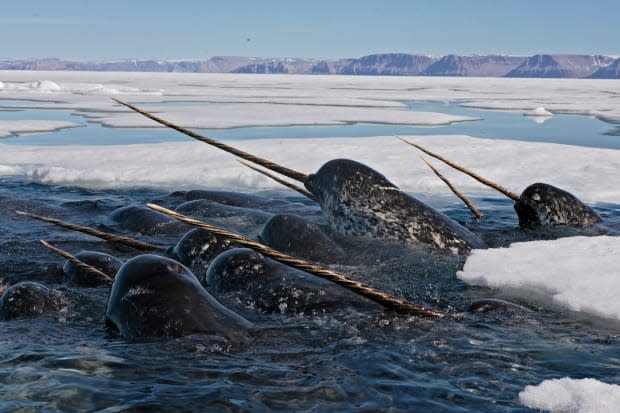Environmental study on Nunavut mine undervalues Inuit knowledge, hunters say
Communities close to Mary River Mine say environmental impacts that the mine's operator calls insignificant are exactly the opposite for Inuit.
"Significance is different to Inuit, from what Baffinland's threshold for change may be," said Amanda Hanson Main, technical advisor for the Mittimatalik Hunters and Trappers Organization in Pond Inlet, Nunavut.
Hanson Main was speaking at this week's technical hearings for an environmental assessment of an expansion to Baffinland Iron Mines Corporation's mine in Nunavut's Qikiqtaaluk region. The expansion would see the mine's annual output doubled.
For example, she said, Baffinland says only 10 per cent of a population of animals near the mine will see impacts, this proportion isn't low when it comes to people's food security.
"For Inuit, if they normally go hunting for 10 days and collect enough narwhal to fill a freezer for winter, in a year when they have to go for 30 days and don't have the same success, it doesn't matter if the measured effect is 10 per cent of the population, Inuit have experienced a significant effect," she said on Tuesday.
We understand communities are feeling changes. We have never predicted that no effects will be felt. - Lou Kamermans, Baffinland
"This is happening now. Inuit are experiencing significant effects, in their knowledge, that this is due to project related activities, the shipping," Hanson Main said.
Her comments followed a presentation by Baffinland to the Nunavut Impact Review Board on the incorporation of Inuit knowledge in its environmental assessment of future mine impacts.
Baffinland's expansion proposal is to increase from a current allowed amount of six million tonnes of iron ore shipped each year, to 12 million tonnes. The project includes building a railway from the mine to Milne Port, and allowing more ship transits during the ice-free season.
The review board requires Baffinland to make a judgment about the significance of impacts caused by changes at the mine.

Now, not later, hunters say
Hunters on the teleconference said they don't see current impacts from the mine being considered as a problem.
Those are changes in narwhal behaviour, fewer seal and sea birds, a loss of fishing places and damage to vegetation and ice because of dust, they said. Communities are also concerned about invasive species that could come from more ships, and about a lack of evidence on how caribou will adapt to crossing a railway.
"Hunters have stated that both narwhal and seal caught this season are skinny, with not much body fat. Therefore, when killed, they can sink immediately," the North Baffin group of community leaders near the mine wrote to the review board on Sept. 9, in a letter on its outstanding concerns.
But the mine's environmental impact statement says there will be no significant impacts to marine mammals from an expansion, the letter states. The North Baffin group said that's "contrary" to the Inuit knowledge in Pond Inlet.
Paul Okalik, Arctic specialist with the World Wildlife Fund and a former Nunavut premier, said switching back and forth between science and Inuit knowledge just "to say you are using it" means that knowledge "will not have strength."
"We were told that we were not to disturb our caribou. And we always listen to this knowledge," he said.

Baffinland says it uses Inuit knowledge
The Mittimatalik hunters group in Pond Inlet asked Baffinland to update its environmental assessment filed with the review board to reflect impacts Inuit are already seeing at the mine.
The company says it relies on Inuit knowledge to assess any impacts an expansion has had or would have.
"We can't commit to revise the assessment. We stand by our assessment," said Lou Kamermans, senior director of sustainable development for Baffinland.
Baffinland says its assessments consider community concerns about the loss of hunting and fishing areas, cabins and camps, the impacts that rotational work would have on family life, and any decrease in food security if harvesting becomes harder or animals are fewer.
Hunters have stated that both narwhal and seal caught this season are skinny, with not much body fat. - North Baffin leaders letter
The company also used Inuit reports on how marine mammals reacted to shipping at the previous Nanisivik mine near Arctic Bay, it said.
These are examples of using Inuit knowledge, said Kamermans.
"We understand communities are feeling changes. We have never predicted that no effects will be felt," said Kamermans. "You can see a change without it necessarily being significant. Significance is a threshold."
The mine has a hunting program through the existing Inuit Impact and Benefit Agreement to help "overcome what is being felt by the community," he said.
An indoor crushing site is also being built at the port site to help reduce the impacts dust would have on drinking water and fish. But there are some parts of the project that are not negotiable, like the railway, because there is no project without them, Kamermans said.
He said hunters will be brought to the new rail line to identify places where more caribou and snowmobile crossings can be built.
"Our preference is to avoid an impact," said Kamermans, but he also said there are methods of compensation built into the agreements Inuit have with the company if any negative impacts happen.
The technical hearings wrap on Friday.


